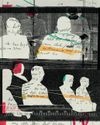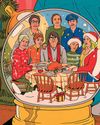
Ah, the world! Oh, the world!
—“Moby-Dick.”
David Gruber began his almost impossibly varied career studying blue-striped grunt fish off the coast of Belize. He was an undergraduate, and his job was to track the fish at night. He navigated by the stars and slept in a tent on the beach. “It was a dream,” he recalled recently. “I didn’t know what I was doing, but I was performing what I thought a marine biologist would do.”
Gruber went on to work in Guyana, mapping forest plots, and in Florida, calculating how much water it would take to restore the Everglades. He wrote a Ph.D. thesis on carbon cycling in the oceans and became a professor of biology at the City University of New York. Along the way, he got interested in green fluorescent proteins, which are naturally synthesized by jellyfish but, with a little gene editing, can be produced by almost any living thing, including humans.
While working in the Solomon Islands, northeast of Australia, Gruber discovered dozens of species of fluorescent fish, including a fluorescent shark, which opened up new questions. What would a fluorescent shark look like to another fluorescent shark? Gruber enlisted researchers in optics to help him construct a special “shark’s eye” camera. (Sharks see only in blue and green; fluorescence, it turns out, shows up to them as greater contrast.) Meanwhile, he was also studying creatures known as comb jellies at the Mystic Aquarium, in Connecticut, trying to determine how, exactly, they manufacture the molecules that make them glow. This led him to wonder about the way that jellyfish experience the world. Gruber enlisted another set of collaborators to develop robots that could handle jellyfish with jellyfish-like delicacy.
この記事は The New Yorker の September 11, 2023 版に掲載されています。
7 日間の Magzter GOLD 無料トライアルを開始して、何千もの厳選されたプレミアム ストーリー、9,000 以上の雑誌や新聞にアクセスしてください。
すでに購読者です ? サインイン
この記事は The New Yorker の September 11, 2023 版に掲載されています。
7 日間の Magzter GOLD 無料トライアルを開始して、何千もの厳選されたプレミアム ストーリー、9,000 以上の雑誌や新聞にアクセスしてください。
すでに購読者です? サインイン

GET IT TOGETHER
In the beginning was the mob, and the mob was bad. In Gibbon’s 1776 “Decline and Fall of the Roman Empire,” the Roman mob makes regular appearances, usually at the instigation of a demagogue, loudly demanding to be placated with free food and entertainment (“bread and circuses”), and, though they don’t get to rule, they sometimes get to choose who will.

GAINING CONTROL
The frenemies who fought to bring contraception to this country.

REBELS WITH A CAUSE
In the new FX/Hulu series “Say Nothing,” life as an armed revolutionary during the Troubles has—at least at first—an air of glamour.

AGAINST THE CURRENT
\"Give Me Carmelita Tropicana!,\" at Soho Rep, and \"Gatz,\" at the Public.

METAMORPHOSIS
The director Marielle Heller explores the feral side of child rearing.

THE BIG SPIN
A district attorney's office investigates how its prosecutors picked death-penalty juries.

THIS ELECTION JUST PROVES WHAT I ALREADY BELIEVED
I hate to say I told you so, but here we are. Kamala Harris’s loss will go down in history as a catastrophe that could have easily been avoided if more people had thought whatever I happen to think.

HOLD YOUR TONGUE
Can the world's most populous country protect its languages?

A LONG WAY HOME
Ordinarily, I hate staying at someone's house, but when Hugh and I visited his friend Mary in Maine we had no other choice.

YULE RULES
“Christmas Eve in Miller’s Point.”